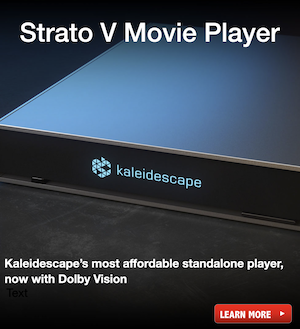Optoma's New 4K UHZ65 Projector Delivers Laser Performance For Under $4.5K
(Optoma) The new UHZ65 4K laser projector(October 11, 2017) Earlier this year we covered Optoma’s announcement of two new bulb-based 4K projectors, both priced below $2,500. Now, Optoma is rocking the home theater world again with the reveal of another true 4K projector, but this one is locked and loaded with a laser light source, making it intriguing in its own right.
“The Optoma UHZ65 is the culmination of years of design iterations, engineering and testing to bring the highest quality home cinema projector to market for a price that consumers can afford,” said Brian Soto, head of product management, Optoma Technology. “With 4K content now readily available, and entertainment options always expanding, we are delivering on our goal to provide an entertainment experience that can truly envelop a room and an audience at home.”
Priced at an astonishing $4,499, the new UHZ65 reads rather well on paper. Using a cutting-edge laser phosphor light source, the projector can produce 3,000 lumens (rated at 20,000 hours), a 2,000,000:1 contrast ratio, and a 140”-plus image. In addition to its 4K chipset capable of displaying 8.3 million distinct pixels, the projector also delivers High Dynamic Range in the form of HDR10 and is specified to cover both REC.2020 and DCI-P3 color spaces.
Optoma says the UHZ65’s image is processed and stabilized by its PureEngine and PureMotion technologies, which are designed to remove image noise, judder, and motion blur during fast motion video playback. Other features include vertical lens shift, a 1.6x zoom, and onboard dual stereo speakers.
Unlike higher priced projectors, the UHZ65 relies on DLP technology which means the rainbow effect could be a potential snag for customers sensitive to that visual byproduct. It also only carries one HDMI 2.0 input (with HDCP 2.2, MHL 2.1, and 18Gbps compliance), with the other deferring to HDMI 1.4a compatibility.
The UHZ65 is an interesting entry in the projector segment, introducing laser light source technology at an insanely low price point. It certainly should appeal to the “must have true 4K functionality” crowd, especially those that use a projector for daily viewing. Ultimately, its ability to produce accurate colors and deliver notable high-contrast performance will dictate its enthusiast-grade value. Nevertheless, the UHZ65 is a welcomed addition to the segment, as Optoma will help to force prices down (not to mention ushering us closer to more affordable laser light source options from other manufacturers).
The UHZ65 is available for purchase now, from ProjectorPeople.com, ProjectorScreen, ProjectorSuperstore, Full Compass and Visual Apex.
Optoma UHZ65 Specifications
- Resolution: Full / native ultra-high-definition 3840×2160 resolution on screen
- Brightness: 3,000 lumens for great viewing in dark room or with ambient light
- Contrast: 2,000,000:1 with Dynamic Black enabled
- Color: HDR-compatible color gamuts Rec.709, REC.2020 and DCI-P3, means incredibly rich colors
- Lamp Life and Type: Its laser phosphor provides a remarkable 20,000 hours of life, eliminating the need to replace the light source throughout the life of the projector
- Imaging Processing and Stability: PureEngine’s PureMotion technology eliminates noise, motion blur, and judder in fast motion video, producing clear and consistently smooth images
- Aspect Ratio: 16×9 native, 4:3 auto, LBX (2160p and 1080p)
- Throw Ratio: 1.39 – 2.22
- Noise: 33/29dB (Bright/ECO)
- Audio: Integrated dual stereo speakers for crisp, loud audio
- I/O: HDMI 1.4a, HDMI 2.0 (with HDCP 2.2, MHL 2.1 and Full 18Gbps), VGA-In, Audio-In (3.5mm), Audio-Out, SDPIF Out (Optical/2 Channel ONLY), USB 2.0 Port (Service), USB-A Power, RJ45, RS232C
Last edited:









